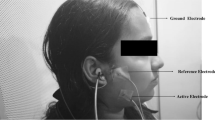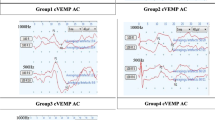Abstract
Purpose
Ageing is process that brings about steady decline in most of the systems, and vestibular system is no different. Although the effects of advancing age on the functioning of the semicircular canals and saccule has been well explored, its impact on the utricle remains the least studied component. While some researchers have investigated the effect of advancing age on the utricular functioning by virtue of studying ocular–vestibular evoked myogenic potentials (oVEMP), the use of smaller sample sizes would hamper the generalization of their results. Therefore, the present study aimed at investigating the effect of advancing age on oVEMP using a substantially larger sample size than the predecessors.
Methods
A total of 480 individuals in the age range of 10–70 years were used as participants and were divided into six age groups, each one defined as a decade. Contralateral oVEMPs were elicited by 500-Hz tone-bursts and averaged over 200 sweeps to obtain the final waveform.
Results
There was a significant decline in the response rates, prolongation of latencies and reduction of peak-to-peak amplitude of oVEMP with increasing age after 50 years (p < 0.05). However, there was no significant difference among the age groups until 50 years of age on any of these parameters (p > 0.05). Further, there was no significant change in inter-aural amplitude difference ratio with increasing age (p > 0.05).
Conclusion
The results of the study confirm significant impact of the ageing process on oVEMP after the age of 50 years and, therefore, age appropriate norms should be considered when using oVEMP for investigating utricular functioning in an individual, especially after the age of 50 years.




Similar content being viewed by others
References
Bowen RL, Atwood CS (2004) Living and dying for sex. Gerontology 50(5):265–290
Birbrair A, Zhang T, Wang ZM, Messi ML, Mintz A, Delbono O (2013) Type-1 pericytes participate in fibrous tissue deposition in aged skeletal muscle. Am J Physiol Cell Physiol 305(11):C1098
Honrubia V, Hoffman LF (1997) Handbook of balance function testing. Singular Publishing Group, San Diego
Desmond AL (2011) Vestibular function: clinical and practical management, 2nd edn. Thieme Medical Publishers, New York
KoizukaI I, Yamakawa J, Naramura H, Kubo T (1995) Time course of vestibular function in patients with Meniere’s disease following vestibular nerve section. Acta Otolaryngol 115(s519):234–237
Beynon GJ, Jani P, Baguley DM (1998) A clinical evaluation of head impulse testing. Clin Otolaryngol Allied Sci 23(2):117–122
Clarke AH (2001) Perspectives for the comprehensive examination of semicircular canal and otolith function. Biol Sci Space 15(4):393–400
Halmagyi GM, Matthew J, Todd MJ (2005) The active head impulse test in unilateral peripheral vestibulopathy. Arch Neurol 62(2):290–293
Helling K, Schonfeld U, Clarke AH (2007) Treatment of Meniere’s disease by low-dosage intratympanic gentamicin application: effect on otolith function. Laryngoscope 117(12):2244–2250
Nguyen KD, Minor LB, Della Santina CC, Carey JP (2009) Vestibular function and vertigo control after intratympanic gentamicin for Meniere’s disease. Audiol Neurotol 14(6):361–372
Andrade IV, Santos-Perez S, Diz PG, Caballero TL, Soto-Varela A (2012) A Correlation between bithermal caloric test results and vestibular evoked myogenic potentials (VEMPs) in normal subjects. Eur Arch Otorhinolaryngol. https://doi.org/10.1007/s00405-012-2167-4
Colebatch JG, Halmagyi GM (1992) Vestibular evoked potentials in human neck muscles before and after unilateral vestibular deafferentation. Neurology 42:1635–1636
Colebatch JG, Halmagyi GM, Skuse NF (1994) Myogenic potentials generated by a click-evoked vestibulocollic reflex. J Neurol Neurosurg Psychiatry 57(2):190–197
Cherchi M, Bellinaso NP, Card K et al (2009) Sound evoked triceps myogenic potentials. Otol Neurotol 30(4):545–550. https://doi.org/10.1097/MAO.0b013e31819d89eb
Cunha LCM, Labanca L, Tavares MC, Goncalves DU (2014) Vestibular evoked myogenic potential (VEMP) with galvanic stimulation in normal subjects. Braz J of otorhinolaryngol 80(1):48–53
Rudisill HE, Hain TC (2008) Lower extremity myogenic potentials evoked by acoustic stimuli in healthy adults. Otol Neurotol 29(5):688–692
Deriu F, Ortu E, Capobianco S et al (2007) Origin of sound-evoked EMG responses in human masseter muscles. J Physiol 580:195–209. https://doi.org/10.1113/jphysiol.2006.123240
Wu CH, Young YH, Murofushi T (1999) Tone burst evoked myogenic potentials in human neck flexor and extensor. Acta Otolaryngol 119:741–744
Sakakura K, Takahashi K, Takayasu Y, Chikamatsu K, Furuya N (2005) Novel method for recording vestibular evoked myogenic potential: minimally invasive recording on neck extensor muscles. Laryngoscope 115:1768–1773
Rosengren SM, Todd NM, Colebatch JG (2005) Vestibular-evoked extraocular potentials produced by stimulation with bone-conducted sound. Clin neurophysiol 116(8):1938–1948
Weber KP, Rosengren SM, Michels R et al (2012) Single motor unit activity in human extraocular muscles during the vestibulo-ocular reflex. J Physiol 590(13):3091–3101
Colebatch JG, Rothwell JC (1993) Vestibular evoked EMG responses in human neck muscles. J Physiol 473:18
Murofushi T, Matsuzaki M, Wu CH (1999) Short tone burst-evoked myogenic potentials on the sternocleidomastoid muscle: are these potentials also of vestibular origin? Arch Otolaryngol Head Neck Surg 125(6):660–664. https://doi.org/10.1001/archotol.125.6.660 (PMID: 10367923)
Curthoys IS (2010) A critical review of the neurophysiological evidence underlying clinical vestibular testing using sound, vibration and galvanic stimuli. Clin Neurophysiol 121:132–144. https://doi.org/10.1016/j.clinph.2009.09.027
Manzari L, Tedesco A, Burgess AM, Curthoys IS (2010) Ocular vestibular-evoked myogenic potentials to bone-conducted vibration in superior vestibular neuritis show utricular function. Otolaryngol Head Neck Surg 143:274–280. https://doi.org/10.1016/j.otohns.2010.03.020
Murofushi T, Wakayama K, Chihara Y (2010) oVEMP to air-conducted tones reflects functions of different vestibular populations from cVEMP? Eur Arch Otorhinolaryngol 267(6):995–996
Taylor R, Wijewardene A, Gibson W et al (2011) The vestibular evoked-potential profile of Meniere’s disease. Clin Neurophysiol 22(6):1256–1263
Govender M, Bush T, Spark A (2009) An accurate and non-labor intensive method for the determination of syringyl to guaiacyl ratio in lignin. Bioresour Technol 100(23):5834–5839
Lin CY, Wang SL, Young YH (2013) Correlations between foam posturography and vestibular-evoked myogenic potential tests in Meniere’s disease. Ear Hear 34(5):673–679
Valko Y, Hegemann SC, Weber KP, Straumann D, Bockisch CJ (2011) Relative diagnostic value of ocular vestibular evoked potentials and the subjective visual vertical during tilt and eccentric rotation. Clin Neurophysiol 122(2):398–404. https://doi.org/10.1016/j.clinph.2010.06.023 (PMID: 20663711)
Curthoys IS, Vulovic V, Manzari L (2012) Ocular vestibular-evoked myogenic potential (oVEMP) to test utricular function: neural and oculomotor evidence. Acta Otorhinolaryngol Ital 32(1):41–45 (PMID: 22500066; PMCID: PMC3324959)
Agarwal Y, Bremova T, Kremmyda O et al (2013) Clinical testing of otolith function: perceptual thresholds and myogenic potentials. J Assoc Res Otolaryngol 14:905–945. https://doi.org/10.1007/s10162-013-0416-x
Xu H, Liang FY, Chen L et al (2016) Evaluation of the utricular and saccular function using oVEMPs and cVEMPs in BPPV patients. J Otolaryngol Head Neck Surg 45:12. https://doi.org/10.1186/s40463-016-0125-7
Singh NK, Barman A (2015) Efficacy of ocular vestibular evoked myogenic potential in identifying posterior semicircular canal benign paroxysmal positional vertigo. Ear Hear 36(2):261–268
Jerin C, Berman A, Krause E, Ertl-Wagner B (2014) Ocular vestibular evoked myogenic potential frequency tuning in certain Meniere’s disease. Hear res 310:54–59
Sinha SK, Shankar K, Sharanya R (2013) Cervical and ocular vestibular evoked myogenic potentials test results in individuals with auditory neuropathy spectrum disorder. Audiol Res 3(1):e4. https://doi.org/10.4081/audiores.2013.e4
Moon IH, Lee CG, Park MK, Lee JD (2012) Cervical vestibular evoked myogenic potential and ocular vestibular evoked myogenic potential in patients with vestibular neuritis and acute viral labyrinthitis. Res Vestib Sci 11(3):92–96
von Brevern M, Radtke A, Lezius F et al (2007) Epidemiology of benign paroxysmal positional vertigo: a population based study. J Neurol Neurosurg Psychiatry 78(7):710–715. https://doi.org/10.1136/jnnp.2006.100420
Liu DH, Kuo CH, Wang CT et al (2017) Age-related increases in benign paroxysmal positional vertigo are reversed in women taking estrogen replacement therapy: a population-based study in Taiwan. Front Aging Neurosci 9:404. https://doi.org/10.3389/fnagi.2017.00404
Alexander T, Harris J (2010) Current epidemiology of Meniere’s syndrome. Otolaryngol Clin North Am 43(5):965–970
Nguyen KD, Welgampola MS, Carey JP (2010) Test-retest reliability and age-related characteristics of the ocular and cervical vestibular evoked myogenic potential tests. Otol Neurotol 31:793–802
Tseng CL, Chou CH, Young YH (2010) Aging effect on the ocular vestibular-evoked myogenic potentials. Otol Neurotol 31(6):959–963
Asal S (2014) Effect of age on ocular vestibular-evoked myogenic potentials using air-conducted sound. Egypt J Otolaryngol 30(2):166–170
Kumar K, Bhat JS, Sequeira NM, Bhojwani KM (2015) Ageing effect on air-conducted ocular vestibular evoked myogenic potential. Audiol Res 5(2):121. https://doi.org/10.4081/audiores.2015.1211
World Medical Association (2013) World Medical Association Declaration of Helsinki: ethical principles for medical research involving human subjects. JAMA 310(20):2191–2194. https://doi.org/10.1001/jama.2013.281053 (PMID: 24141714)
Singh NK, Kashyap RS, Supreetha L, Sahana V (2014) Characterization of age-related changes in sacculocolic response parameters assessed by cervical vestibular evoked myogenic potentials. Eur Arch Oto-Rhino-L 271(7):1869–1877
Chiarovano E, Zamith F, Vidal PP, de Waele C (2011) Ocular and cervical VEMPs: a study of 74 patients suffering from peripheral vestibular disorders. Clin Neurophysiol 122(8):1650–1659
Chihara Y, Iwaski S, Ushio M, Murofushi T (2007) Vestibular-evoked extraocular potentials by air-conducted sound: another clinical test for vestibular function. Clin Neurophysiol 18(12):1745–1751
Singh NK, Barman A (2013) Characterizing the frequency tuning properties of air-conduction ocular vestibular evoked myogenic potentials in healthy individuals. Int J Audiol 52:849–854
Singh NK, Barman A (2014) Characterizing the effects of frequency on parameters of short tone-bursts induced ocular vestibular evoked myogenic potentials. J Indian Speech Hear Assoc 28(1):1–9
Winters SM, Campschroer T, Grolman W, Klis SF (2011) Ocular vestibular evoked myogenic potentials in response to air-conducted sound in Meniere’s disease. Otol Neurotol 32(8):1273–1280
Singh NK, Valappil N, Mithlaj JA (2015) Response rates and test-retest reliability of ipsilateral and contralateral ocular vestibular evoked myogenic potential in healthy adults. Hear Balance Commun 13(3):126–133
Rosengren SM, Colebatch JG, Straumann D, Weber KP (2013) Why do oVEMPs become larger when you look up? Explaining the effect of gaze elevation on the ocular vestibular evoked myogenic potential. Clin Neurophysiol 24(4):785–791
Govender S, Rosengren SM, Colebatch JG (2011) Vestibular neuritis has selective effects on air- and bone-conducted cervical and ocular vestibular evoked myogenic potentials. Clin Neurophysiol 122(6):1246–1255
Murnane OD, Akin FW, Kelly JK, Byrd S (2011) Effects of stimulus and recording parameters on the air conduction ocular vestibular evoked myogenic potential. J Am Acad Audiol 22(7):469–480
Kantner C, Gürkov R (2014) The effects of commonly used upward gaze angles on ocular vestibular evoked myogenic potentials. Otol Neurotol 35(2):289–293. https://doi.org/10.1097/MAO.0b013e318299a812 (PMID: 23988989)
Singh NK, Kadisonga P, Ashitha P (2014) Optimizing stimulus repetition rate for recording ocular vestibular evoked myogenic potential elicited by air-conduction tone bursts of 500 Hz. Audiol Res 4(88):14–20
Wang SJ, Jaw FS, Young YH (2013) Optimizing the bandpass filter for acoustic stimuli in recording ocular vestibular-evoked myogenic potentials. Neurosci Let 542:12–16
McNemar Q (1947) Note on the sampling error of the difference between correlated proportions or percentages. Psychometrika 12(2):153–157
Rosenhall U (1973) Degenerative patterns in the aging human vestibular neuro-epithelia. Acta Otolaryngol 76:208–220
Tang Y, Lopez I, Baloh RW (2001–2002) Age-related change of the neuronal number in the human medial vestibular nucleus: a stereological investigation. J Vestibul Res 11(6): 357–363
Davis AC (1990) Epidemiological profile of hearing impairments: the scale and nature of the problem with special reference to the elderly. Acta Otolaryngol Suppl 476:23–31
Nash SD, Cruickshanks KJ, Klein R et al (2011) The prevalence of hearing impairment and associated risk factors: the Beaver Dam Offspring Study. Arch Otolaryngol Head Neck Surg 137:432–439
Engstrom H, Bergstom B, Rosenahll U (1974) Vestibular sensory epithelia. Arch Otolaryngol 100(6):411–418
Rosenhall U (1974) Epithelial cysts in the human vestibular apparatus. J Laryngol Otol 88:105–112
Rosenhall U, Rubin W (1975) Degenerative changes in the human vestibular sensory epithelia. Acta Otolaryngol 79:67–80
Funding
The authors received no funds from any grants or any other resources.
Author information
Authors and Affiliations
Corresponding author
Ethics declarations
Conflict of interrest
The authors have no conflicts of interest to disclose.
Ethical approval
The method used in the study was approved by the institutional review board and the Bio-behavioral research ethics committee of the institute as a part of doctoral thesis.
Informed consent
Prior to the testing, each participant was described regarding the experiment and subsequently a written consent for participation was obtained.
Additional information
Publisher's Note
Springer Nature remains neutral with regard to jurisdictional claims in published maps and institutional affiliations.
Rights and permissions
About this article
Cite this article
Singh, N.K., Firdose, H. Characterizing the impact of advancing age on 500 Hz tone-burst evoked ocular–vestibular evoked myogenic potentials. Eur Arch Otorhinolaryngol 278, 4259–4268 (2021). https://doi.org/10.1007/s00405-020-06542-2
Received:
Accepted:
Published:
Issue Date:
DOI: https://doi.org/10.1007/s00405-020-06542-2




